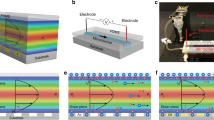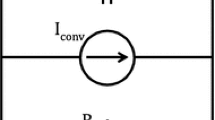Abstract
In this work, the shear-induced electrokinetic streaming potential present in free-surface electrolytic flows subjected to a gradient in surface tension is assessed. Firstly, for a Couette flow with fully resolved electric double layer (EDL), the streaming potential per surface stress as a function of the Debye parameter and ζ-potential is analyzed. By contrast to the Smoluchowski limit in pressure-driven channel flow, the shear-induced streaming potential vanishes for increasing Debye parameter (infinitely thin EDL), unless the free surface contains (induced) surface charge or the flow at the charged, solid wall is permitted to slip. Secondly, a technical realization of surface-tension-induced streaming is proposed, with surface stress acting on the free (slipping) surfaces of a micro-structured, superhydrophobic wall. The streaming potential is analyzed with respect to the slip parameter and surface charge. Finally, the surface tension is assumed to vary with temperature (thermocapillarity) or with surfactant concentration (destillocapillarity). The maximal thermal efficiency is derived and compared to the Carnot efficiency. For large thermal Marangoni number, the efficiency is severely limited by the large heat capacity of aqueous solvents. By contrast, destillocapillary flows may reach conversion efficiencies similar to pressure-driven flow.





Similar content being viewed by others
Notes
Since only half of the channel height is considered, the corresponding total external resistance for the full channel, i.e., two half-systems in parallel, is \(R/2\).
References
Bell LE (2008) Cooling, heating, generating power, and recovering waste heat with thermoelectric systems. Science 321:1457–1461
Biswas K, He J, Blum ID, Wu CI, Hogan TP, Seidman DN, Dravis VP, Kanatzidis MG (2012) High-performance bulk thermoelectrics with all-scale hierarchical architectures. Nature 489:414–418
Chen H, Goswami DY, Stefanakos EK (2010) A review of thermodynamic cycles and working fluids for the conversion of low-grade heat. Renew Sustain Energy Rev 14:3059–3067
de Surgy GN, Chabrerie JP, Denoux O, Wesfreid JE (1993) Linear growth of instabilities on a liquid metal under normal electric field. J Phys II France 3:1201–1225
Dietzel M, Hardt S (2012) Streaming potential of an electrolyte in a microchannel with a lateral temperature gradient, In: Proceedings of 3rd conference on microfluidics, Heidelberg 39 (\(\mu\)Flu12-108), pp 1–9
Dietzel M, Hardt S (2015) Flow and streaming potential of an electrolyte in a channel with an axial temperature gradient. J Fluid Mech (in preparation)
Drelich J, Chibowksi E, Meng DD, Terpilowski K (2011) Hydrophilic and superhydrophilic surfaces and materials. Soft Matter 7:9804
Duffin AM, Saykally RJ (2008) Electrokinetic power generation from liquid water microjets. J Phys Chem C 112:17018–17022
Gao Y, Wong TN, Yang C, Ooi KT (2005) Transient two-liquid electroosmotic flow with electric charges at the interface. Colloids Surf A 266(1):117–128
Gradshteyn IS, Ryzhik IM (2007) Table of integrals, series, and products, 7th edn. Academic Press, New York
Grosu FP, Bologa MK (2010) Thermoelectrohydrodynamic methods of energy conversion. Surf Eng Appl Electrochem 46(6):582–588
Joo SW (2008) A new hydrodynamic instability in ultra-thin film flows induced by electro-osmosis. J Mech Sci Technol 22:382–386
Karakashev SI, Teskov R (2011) Electro-Marangoni effect in thin liquid films. Langmuir 27:2265–2270
Lawrentjew MA, Schabat BW (1967) Methoden der komplexen Funktionentheorie. VEB Deutscher Verlag der Wissenschaften, Berlin
Lee JSH, Barbulovic-Nad I, Wu Z, Xuan X, Li D (2006) Electrokinetic flow in a free surface-guided microchannel. J Appl Phys 99:054905
Marín AG, van Hoeve W, García-Sánchez P, Shui L, Xie Y, Fontelos MA, Eijkel JCT, van den Berg A, Lohse D (2013) The microfluidic Kelvin water dropper. Lab Chip 13(23):4489–4682
Mayur M, Amiroudine S, Lasseux D (2012) Free-surface instability in electro-osmotic flows of ultrathin liquid films. Phys Rev E 85:046301
Melcher JR, Taylor GI (1969) Electrohydrodynamics: a review of the role of interfacial stresses. Annu Rev Fluid Mech 1:111–146
Mugele F, Baret JC (2005) Electrowetting: from basics to applications. J Phys Condens Mater 17:R705–R774
Oelkers EH, Helgeson HC (1989) Calculation of the transport properties of aqueous species at pressures to 5 kb and temperatures to 1000 \(^\circ \text{ C }\). J Sol Chem 18(7):601–640
Oh JM, Manukyan G, den Ende DV, Mugele F (2011) Electric-field-driven instabilities on superhydrophobic surfaces. Europhys Lett 93(5):56001
Philip JR (1972) Flows satisfying mixed no-slip and no-shear conditions. Z Angew Math Phys 23:353–372
Philip JR (1972) Integral properties of flows satisfying mixed no-slip and no-shear conditions. Z Angew Math Phys 23:960–968
Qian S, Joo SW, Jiang Y, Cheney MA (2009) Free-surface problems in electrokinetic micro- and nanofluidics. Mech Res Commun 36:82–91
Riffat SB, Ma X (2003) Thermoelectrics: a review of present and potential applications. Appl Therm Eng 23:913–935
Russel WB, Saville DA, Schowalter WR (1989) In: Batchelor GK (ed) Colloidal dispersion. Cambridge University Press, Cambridge
Saha BB, Koyama S, Kashiwagi T, Akisawa A, Ng KC, Chua HT (2003) Waste heat driven dual-mode, multi-stage, multi-bed regenerative adsorption system. Int J Refrig 26:749–757
Salata OV (2005) Tools of nanotechnology: electrospray. Curr Nanosci 1:25–33
Saqr KM, Musa MN (2009) Critical review of thermoelectrics in modern power generation applications. Therm Sci 13(3):165–174
Schönecker C, Baier T, Hardt S (2014) Influence of the enclosed fluid on the flow over a microstructured surface in the Cassie state. J Fluid Mech 740:168–195
Seshadri G, Baier T (2013) Effect of electro-osmotic flow on energy conversion on superhydrophobic surfaces. Phys Fluids 25:042002
Shakouri A (2011) Recent developments in semiconductor thermoelectric physics and materials. Ann Rev Mater Res 41:399–431
Squires TM (2008) Electrokinetic flows over inhomogeneously slipping surfaces. Phys Fluids 20(9):092105
Steffes C, Baier T, Hardt S (2011) Enabling the enhancement of electroosmotic flow over superhydrophobic surfaces by induced charges. Colloids Surf A 376(1):85–88
Taylor GI, McEwan AD (1965) The stability of a horizontal fluid interface in a vertical electric field. J Fluid Mech 22:1–15
Tchanche BF, Lambrinos G, Frangoudakis A, Papadakis G (2011) Low-grade heat conversion into power using organic Rankine cycles—a review of various applications. Renew Sustain Energy Rev 15:3963–3979
Thomson W (1867) On a self-acting apparatus for multiplying and maintaining electric charges, with applications to illustrate the voltaic theory. Proc R Soc Lond 16(67):67–72
Tsekov R, Ivanova DS, Slavchov R, Radoev B, Manev ED, Nguyen AV, Karakashev SI (2010) Streaming potential effect on the drainage of thin liquid films stabilized by ionic surfactants. Langmuir 27(7):4703–4708
van der Heyden FHJ, Stein D, Dekker C (2005) Streaming currents in a single nanofluidic channel. Phys Rev Lett 95:116104
van der Heyden HJ, Bonthuis DJ, Stein D, Meyer C, Dekker C (2006) Electrokinetic energy convertion in nanofluidic channels. Nano Lett 6(10):2232–2237
Watanabe T, Nakajima A, Wang R, Minabe M, Koizumi S, Fujishima A, Hashimoto K (1999) Photocatalytic activity and photoinduced hydrophilicity of titanium dioxide coated glass. Thin Solid Films 351:260–263
Xuan X, Li D (2005) Thermodynamic analysis of electrokinetic energy conversion. J Power Sources 156:677–684
Yang J, Lu F, Kostiuk LW, Kwok DY (2003) Electrokinetic microchannel battery by means of electrokinetic and microfluidic phenomena. J Micromech Microeng 13:963–970
Zhao H (2011) Streaming potential generated by a pressure-driven flow over superhydrophobic stripes. Phys Fluids 23:022003
Acknowledgments
This work was in part supported by the German Research Foundation (DFG) through Cluster of Excellence 259, ‘Center of Smart Interfaces.’ Steffen Hardt is acknowledged for fruitful discussion.
Author information
Authors and Affiliations
Corresponding author
Appendix: Solution details of the Laplace equation
Appendix: Solution details of the Laplace equation
The velocity field between parallel plates containing periodic patches of no-slip and constant shear regions was estimated using the result by Philip, Eq. (30), for such a flow in an infinite half-plane, \(y\ge 0\). No analytical result is known for a finite plate separation. However, the range of validity of this approximation can be assessed numerically. For this, the Laplace equation, \(\nabla ^2 w =0\), was discretized using the finite element method as implemented in the commercial code Comsol Multiphysics. By symmetry, the computational domain can be restricted to a unit cell indicated by the gray area in Fig. 4. The boundary conditions are \(w(x,0) = 0\) for \(0<x<(1-a)W\) (at the solid wall) and \(\eta \partial _y w(x,0) = -\tau\) for \((1-a)W<x<W\) (at the constant shear surface). On all other boundaries symmetry conditions apply, i.e., \((\mathbf {n} \cdot \mathbf {\nabla }) w = 0\) with \(\mathbf {n}\) being the outward normal at the boundary. The average velocity, \((HW)^{-1}\int _0^H\!\!\int _0^W\!\! w\,{\mathrm{d}}x\,{\mathrm{d}}y\), normalized with the analytic value corresponding to Philip’s solution, \(\beta _\Vert W \tau /\eta\), is tabulated in Table 1 for different values of the free-surface fraction, \(a=B/W\), and aspect ratio, \(H/W\). It is evident from the table that for \(H/W=1\) the numerically obtained results deviate by only \(\mathcal{O}(10^{-3})\) from the corresponding analytical result and even for \(H/W=0.75\) the agreement is \(\mathcal{O}(10^{-2})\).
For the analysis presented in the main text, flow rates and line averages of the velocity field are needed. Normalized with the length or area of the integration region, these averages turn out to be identical, attesting the relevance of Table 1. In fact, even for finite H, one can show that
for any \(0\le y_0 < y_1 \le H\); thus, line averages and the flow rate are inherently linked. A sketch of a proof of this relation is as follows: Since \(w\) is harmonic, \(\nabla ^2 w=0\), it is the imaginary part of a holomorphic function \(f(x+iy)=v(x,y)+iw(x,y)\) with \(v,w:\mathbb {R}^2\rightarrow \mathbb {R}\), (Lawrentjew and Schabat 1967). By Cauchy’s integral theorem, \({\text {Im}}[\oint _\gamma f({\xi })d\xi ]=0\) for any closed path \(\gamma\). Choose \(\gamma\) as the rectangle with vertices \(\xi =iy_0\), \(2W+iy_0\), \(2W+iy_1\), \(iy_1\) as shown in Fig. 6. Due to the Cauchy–Riemann conditions, \(v(x,H)\) is constant since \(\partial _x v|_{y=H} =-\partial _y w|_{y=H}=0\); similarly, \(v(0,y)\) and \(v(2W,y)\) are constant since \(\partial _x w|_{x=0}=0=\partial _x w|_{x=2W}\). Thus, not only \(w(x,y)=w(x+2W,y)\) is periodic in \(x\), but so is \(v\) and thus \(f\). The line integrals on the legs with constant x thus cancel, which completes the proof.
Rights and permissions
About this article
Cite this article
Pini, C., Baier, T. & Dietzel, M. Energy conversion by surface-tension-driven charge separation. Microfluid Nanofluid 19, 721–735 (2015). https://doi.org/10.1007/s10404-015-1597-x
Received:
Accepted:
Published:
Issue Date:
DOI: https://doi.org/10.1007/s10404-015-1597-x





